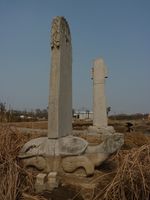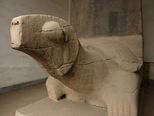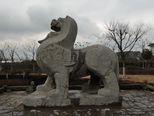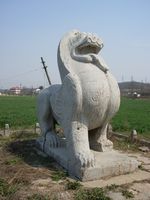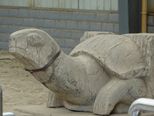أسرة ليانگ
Liang 梁 | |||||||||||||||
|---|---|---|---|---|---|---|---|---|---|---|---|---|---|---|---|
| 502–557 | |||||||||||||||
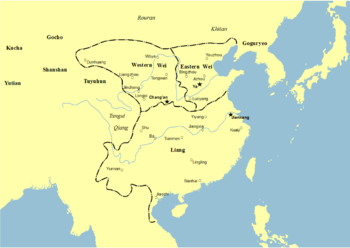 Liang and neighbors | |||||||||||||||
| العاصمة | Jiankang (502–552, 555–557) Jiangling (552–553) | ||||||||||||||
| الحكومة | Monarchy | ||||||||||||||
| Emperor | |||||||||||||||
• 502–549 | Emperor Wu of Liang | ||||||||||||||
• 549–551 | Emperor Jianwen of Liang | ||||||||||||||
• 552–555 | Emperor Yuan of Liang | ||||||||||||||
• 555–557 | Emperor Jing of Liang | ||||||||||||||
| التاريخ | |||||||||||||||
• تأسست | 30 April[1] 502 | ||||||||||||||
| 24 April 549[2] | |||||||||||||||
• Jiangling's fall to Western Wei | 7 January 555[3] | ||||||||||||||
• Emperor Jing's yielding the throne to Chen Baxian | 16 November 557 | ||||||||||||||
• انحلت | 16 November 557 | ||||||||||||||
| |||||||||||||||
| Today part of | |||||||||||||||
The Liang dynasty (الصينية: 梁朝; پنين: Liáng cháo) (502–557), also known as the Southern Liang dynasty (南梁), was the third of the Southern Dynasties during China's Southern and Northern Dynasties period. It was located in East China and South China, and replaced by the Chen dynasty in 557. The small rump state Western Liang (555–587), located in Central China, continued until its annexation in 587.
Rule
During the Liang dynasty, in 547 a Persian embassy paid tribute to the Liang, amber was recorded as originating from Persia by the Book of Liang.[4]
Emperors
| Posthumous Name | Family name and given names | Period of Reigns | Era names and their according range of years |
|---|---|---|---|
| Convention: Liang + posthumous name | |||
Emperor Wu of Liang - Wu Di
|
Xiao Yan (蕭衍 Xiāo Yǎn) | 502-549[5] | Tianjian (天監 tiān-jiān) 502-519 Putong (普通 pǔ-tōng) 520-527 Datong (大通 dà-tōng) 527-529 Zhongdatong (中大通 zhōng-dà-tōng) 529-534 Datong (大同 dà-tóng) 535-546 Zhongdatong (中大同 zhōng-dà-tóng) 546-547 Taiqing (太清 tài-qīng) 547-549 |
Emperor Jianwen of Liang - Jianwen Di
|
Xiao Gang (蕭綱 xiāo gāng) | 549-551 | Dabao (大寶 dà bǎo) 550-551 |
Prince of Yuzhang - Yu Zhang Wang
|
蕭棟 xiāo dòng | 551-552 | Tianzheng (天正 tiān zhèng) 551-552 |
Emperor Yuan of Liang - Yuan Di
|
蕭繹 xiāo yì | 552-555[6] | Chengsheng (承聖 chéng shèng) 552-555 |
Marquess of Zhenyang - Zhen Yang Hou
|
蕭淵明 xiāo yuān míng | 555 | Tiancheng (天成 tiān chéng) 555 |
Emperor Jing of Liang - Jing Di
|
蕭方智 xiāo fāng zhì | 555-557[7] | Shaotai (紹泰 shào tài) 555-556 Taiping (太平 tài píng) 556-557 |
Rulers family tree
| Liang dynasty and Western Liang | ||||||||||||||||||||||||||||||||||||||||||||||||||||||||||||||||||||||||||||||||||||||||||||||||||||||||||||||||||||||||||||||||||||||||||||||||||||||||||||||||||||||||||||||||||||||||||||||||||||||||||||||||||||||||||||||||||||||||||||||||||||||||||||||||||||||||||||||||||||||||||||||||||||||||||||||||||||||||||||||||||||||||||||||||||||||||||||||||||||||||||||||||||||||||||||||||||||||||||||||||||||||||||||||||||||||||||||||||||||||||||||||||||||||||||||||||||||||||||||||||||||||||||||||||||||||||||||||||||||||||||||||||||||||||||||||||||||||||||||||||||||||||||||||||||||||||||||||||||||||||||||||||||||||||||||||||||||||||||||||||||||||||||||||||||||||||||||||||||||||||||||||||||||||||||||||||||||||||||||||||||||||||||||||||||||||||||||||||||||||||||||||||||||||||||||||||||||||||||||||||||||||||||
|---|---|---|---|---|---|---|---|---|---|---|---|---|---|---|---|---|---|---|---|---|---|---|---|---|---|---|---|---|---|---|---|---|---|---|---|---|---|---|---|---|---|---|---|---|---|---|---|---|---|---|---|---|---|---|---|---|---|---|---|---|---|---|---|---|---|---|---|---|---|---|---|---|---|---|---|---|---|---|---|---|---|---|---|---|---|---|---|---|---|---|---|---|---|---|---|---|---|---|---|---|---|---|---|---|---|---|---|---|---|---|---|---|---|---|---|---|---|---|---|---|---|---|---|---|---|---|---|---|---|---|---|---|---|---|---|---|---|---|---|---|---|---|---|---|---|---|---|---|---|---|---|---|---|---|---|---|---|---|---|---|---|---|---|---|---|---|---|---|---|---|---|---|---|---|---|---|---|---|---|---|---|---|---|---|---|---|---|---|---|---|---|---|---|---|---|---|---|---|---|---|---|---|---|---|---|---|---|---|---|---|---|---|---|---|---|---|---|---|---|---|---|---|---|---|---|---|---|---|---|---|---|---|---|---|---|---|---|---|---|---|---|---|---|---|---|---|---|---|---|---|---|---|---|---|---|---|---|---|---|---|---|---|---|---|---|---|---|---|---|---|---|---|---|---|---|---|---|---|---|---|---|---|---|---|---|---|---|---|---|---|---|---|---|---|---|---|---|---|---|---|---|---|---|---|---|---|---|---|---|---|---|---|---|---|---|---|---|---|---|---|---|---|---|---|---|---|---|---|---|---|---|---|---|---|---|---|---|---|---|---|---|---|---|---|---|---|---|---|---|---|---|---|---|---|---|---|---|---|---|---|---|---|---|---|---|---|---|---|---|---|---|---|---|---|---|---|---|---|---|---|---|---|---|---|---|---|---|---|---|---|---|---|---|---|---|---|---|---|---|---|---|---|---|---|---|---|---|---|---|---|---|---|---|---|---|---|---|---|---|---|---|---|---|---|---|---|---|---|---|---|---|---|---|---|---|---|---|---|---|---|---|---|---|---|---|---|---|---|---|---|---|---|---|---|---|---|---|---|---|---|---|---|---|---|---|---|---|---|---|---|---|---|---|---|---|---|---|---|---|---|---|---|---|---|---|---|---|---|---|---|---|---|---|---|---|---|---|---|---|---|---|---|---|---|---|---|---|---|---|---|---|---|---|---|---|---|---|---|---|---|---|---|---|---|---|---|---|---|---|---|---|---|---|---|---|---|---|---|---|---|---|---|---|---|---|---|---|---|---|---|---|---|---|---|---|---|---|---|---|---|---|---|---|---|---|---|---|---|---|---|---|---|---|---|---|---|---|---|---|---|---|---|---|---|---|---|---|---|---|---|---|---|---|---|---|---|---|---|---|---|---|---|---|---|---|---|---|---|---|---|---|---|---|---|---|---|---|---|---|---|---|---|---|---|---|---|---|---|---|---|---|---|---|---|---|---|---|---|---|---|---|---|---|---|---|---|---|---|---|---|---|---|---|---|---|---|---|---|---|---|---|---|---|---|---|---|---|---|---|---|---|---|---|---|---|---|---|---|---|---|---|---|---|---|---|---|---|---|---|---|---|---|---|---|---|---|---|---|---|---|---|---|---|---|---|---|---|---|---|---|---|---|---|---|---|---|---|---|---|---|---|---|---|---|---|---|---|---|---|---|---|---|---|---|---|---|---|---|---|---|---|---|---|---|---|---|---|---|---|---|---|---|---|---|---|---|---|---|---|---|---|---|---|---|---|---|---|---|---|---|---|---|---|---|---|---|---|---|---|---|---|---|---|---|---|---|---|---|---|---|---|---|---|---|---|---|---|---|---|---|---|---|---|---|---|---|---|---|---|---|
|
- Liang emperors - Western Liang emperors - Liang throne pretenders
| ||||||||||||||||||||||||||||||||||||||||||||||||||||||||||||||||||||||||||||||||||||||||||||||||||||||||||||||||||||||||||||||||||||||||||||||||||||||||||||||||||||||||||||||||||||||||||||||||||||||||||||||||||||||||||||||||||||||||||||||||||||||||||||||||||||||||||||||||||||||||||||||||||||||||||||||||||||||||||||||||||||||||||||||||||||||||||||||||||||||||||||||||||||||||||||||||||||||||||||||||||||||||||||||||||||||||||||||||||||||||||||||||||||||||||||||||||||||||||||||||||||||||||||||||||||||||||||||||||||||||||||||||||||||||||||||||||||||||||||||||||||||||||||||||||||||||||||||||||||||||||||||||||||||||||||||||||||||||||||||||||||||||||||||||||||||||||||||||||||||||||||||||||||||||||||||||||||||||||||||||||||||||||||||||||||||||||||||||||||||||||||||||||||||||||||||||||||||||||||||||||||||||||
Artistic heritage
Tombs of a number of members of the ruling Xiao family, with their sculptural ensembles, in various states of preservation, are located near Nanjing.[8] The best surviving example of the Liang dynasty's monumental statuary is perhaps the ensemble of the Tomb of Xiao Xiu (475–518), a brother of Emperor Wu, located in Qixia District east of Nanjing.[9][10]
- Tombs of the Liang Dynasty
A turtle-borne stele and a pillar; tomb of Xiao Hong
A turtle-borne stele; tomb of Xiao Dan
A stele-bearing turtle; tomb of Xiao Xiu
Two bixies near the tomb of Xiao Zhengli
انظر أيضاً
- King of Liang
- Book of Liang
- Book of Zhou
- History of Northern Dynasties
- History of Southern Dynasties
- Zizhi Tongjian
الهامش
- ^ Zizhi Tongjian, vol. 145.
- ^ Zizhi Tongjian, vol. 162.
- ^ Book of Liang, vol. 5.
- ^ Maurice Fishberg (1907). Materials for the physical anthropology of the eastern European Jews, Issues 1-6 (reprint ed.). New Era Print. Co. p. 233. Retrieved 12 June 2011.
- ^ Emperor Wu's nephew Xiao Zhengde the Prince of Linhe, who joined Hou Jing's rebellion, was declared emperor by Hou in 548, but after Hou's victory over Emperor Wu in 549 was deposed and killed by Hou, and is not usually considered a true emperor.
- ^ Emperor Yuan's brother Xiao Ji the Prince of Wuling also declared himself emperor in 552, but was defeated and killed by Emperor Yuan in 553, and is usually not considered a true emperor.
- ^ In 558, a year after Emperor Jing had yielded the throne to Chen Baxian (and had been killed by Chen), his nephew Xiao Zhuang the Prince of Yongjia, with support from Northern Qi, was proclaimed the emperor of Liang by the general Wang Lin. In 560, Wang Lin defeated the Chen troops, and both he and Xiao Zhuang were forced to flee to Northern Qi. It is a matter of controversy whether Xiao Zhuang should be considered an emperor of Liang.
- ^ "Mausoleum Stone Carvings of Southern Dynasties in Nanjing". chinaculture.org. Archived from the original on July 25, 2011.
{{cite web}}: Unknown parameter|deadurl=ignored (|url-status=suggested) (help) - ^ Albert E. Dien, «Six Dynasties Civilization». Yale University Press, 2007 ISBN 0-300-07404-2. Partial text on Google Books. P. 190. A reconstruction of the original form of the ensemble is shown in Fig. 5.19.
- ^ 梁安成康王萧秀墓石刻 Archived 2013-10-19 at the Wayback Machine (Sculptures at the Tomb of Xiao Xiu) (صينية) (description and modern photos)
وصلات خارجية
- CS1 errors: unsupported parameter
- Articles containing صينية-language text
- Pages using infobox country with unknown parameters
- Former country articles categorised by government type
- Articles containing Chinese-language text
- دول وأقاليم تأسست في the 500s
- States and territories disestablished in the 550s
- Liang dynasty
- 557 disestablishments
- بلدان سابقة في التاريخ الصيني
- 502 establishments
- 6th-century establishments in China
- 6th-century disestablishments in China
